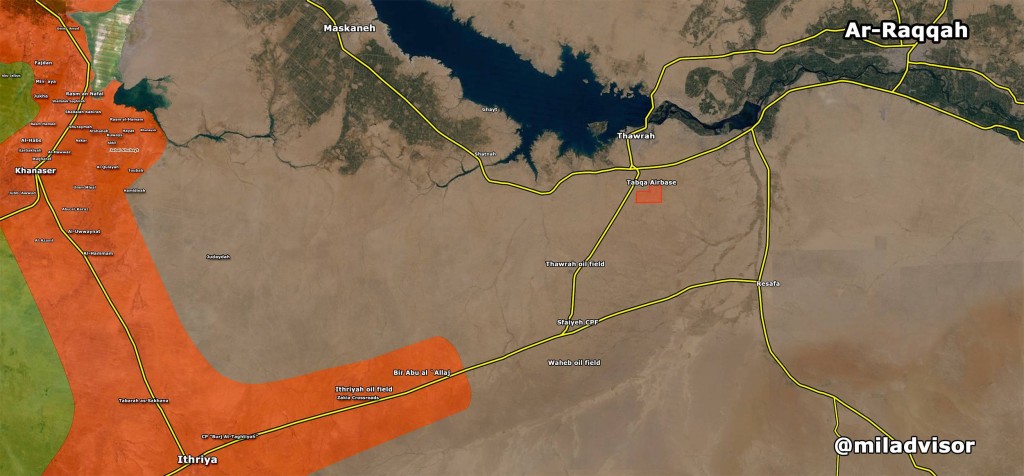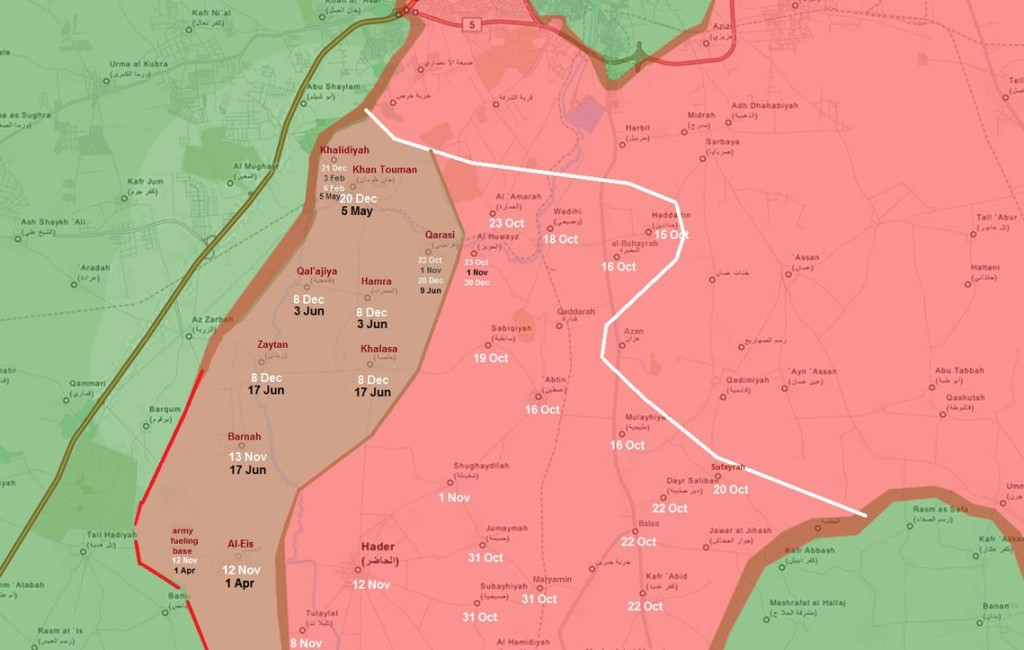PHOTO: Remains of a Russian bomb dropped on the US-supported New Syrian Army last Thursday
LATEST
- ISIS Counter-Attack v. Syrian Military in Raqqa Province
- Video: State Media Accidentally Shows Russia’s Use of Cluster Bombs
- Regime Seeks Breakthrough in East Ghouta
- Video: Claimed Russian Airstrike on Field Hospital in Aleppo
- Reports: Rebels Reopen Darayya-Moadamiya Link, Southwest of Damascus
- Claims: 50+ Hezbollah Fighters Killed in Failed Defense South of Aleppo
- Video: Aid to East Ghouta — But The Truck is Empty
LATEST
Analysis: The Case for A Responsible US Intervention
Responding to US criticism, Russia has tried to cover up its deliberate bombing of an American-supported force fighting the Islamic State in southeastern Syria.
The Defense Ministry said on Sunday that Russian officials had held a video conference with US counterparts over Thursday’s double airstrikes on the New Syrian Army near the al-Tanf crossing, close to the Iraqi and Jordanian borders.
US FA-18 fighters diverted to al-Tanf after the first of the two Russian strikes, calling on the Russians on an agreed channel but not receiving an answer. As soon as the US jets left the area to refuel, the Russians made another bomb run, attacking rescuers who had convened to help victims of the first attack. Photos have been posted of cluster bombs amid the munitions.
The Pentagon said that it used Saturday’s video conference to “expresse strong concerns about the attack” which “created safety concerns for US and coalition forces”.
However, the Russian Defense Ministry blamed the US on Sunday. It said that “the American side did not provide the coordinates of the areas where troops are under its control”.
The Ministry justified the site of the attack by claiming that it “proved the bombed objective was more than 300 kilometers (185 miles) from the territory the US side claimed as the areas where the opposition acts”.
The statement did not explain why the NSA position at al-Tanf was “hostile territory”, given that the New Syrian Army is battling the Islamic State — the same ISIS that Russia is purportedly fighting with its military intervention from September on behalf of the Assad regime.
The Ministry did not say why Russian pilots had failed to respond to US calls, nor did it say why the warplanes returned to bomb after the American F-18s had left to refuel.
Without giving any assurances about future targets, it said that the video conference had discussed “how to prevent incidents and to provide security of flights”.
ISIS Counter-Attack v. Syrian Military in Raqqa Province
An Islamic State counter-attack has pushed back the Syrian military and militia in Raqqa Province in northern Syria.
Just over two weeks ago, the pro-Assad offensive entered the province for the first time since 2014, when ISIS overran the Taqba Airbase. It advanced east along a main route until a week ago, when it reached the Sfaiyeh roundabout week, about 15 km (9 miles) south of the airbase and 45 km (28 miles) from the city of Raqqa.
On Monday, the Islamic State struck — reportedly with attacks including a series of suicide vehicle bombs — and retook part of the highway and Sfaiyeh oilfield.

Pro-Assad area in orange; Islamic State in gray (Map: Military Advisor)
Video: State Media Accidentally Shows Russia’s Use of Cluster Bombs
State broadcaster RT, in a report on the sudden visit of Defense Minister Sergei Shoigu to Syria last weekend, has inadvertently shown cluster munitions on Russian warplanes:
RT cuts incendiary cluster bombs footage from Syria airbase video, but you can't delete anything from the Internet:https://t.co/12mSDaWiYr
— CIT (en) (@CITeam_en) June 20, 2016
The use of cluster bombs is illegal under a 2010 international convention, and Moscow has denied that it has dropped them in Syria.
After observers on social media exposed RT’s censorship, the broadcaster restored the clip showing the munitions.
Regime Seeks Breakthrough in East Ghouta
Pro-Assad forces are seeking a further advance in the East Ghouta area near Damascus, trying to overrun the rebel faction Jaish al-Islam at points along the Damascus-to-Homs highway.
The fighting is along the strategic al-Bahariyah frontline:
Fierce fighting to stop infiltration attempt by Assad militia at the Albaryg frontline causing loses amongst themhttps://t.co/weh56geCc0
— Army Of Islam (@Islamarmy_eng3) June 20, 2016
The Syrian military and allies took much of the southern part of East Ghouta in April and May, taking advantage of rebel in-fighting that weakened defenses.
See Syria Daily, May 22: Regime and Hezbollah Press Offensive Near Damascus
Footage of the clashes from a pro-rebel account:
And from a pro-regime account:
Video: Claimed Russian Airstrike on Field Hospital in Aleppo
Pro-opposition Halab News has posted footage of an airstrike, reportedly from a Russian warplane, on the children’s section of a field hospital in opposition-held Aleppo:
#شاهد | لحظة استهداف الطيران الحربي الروسي قسم الأطفال في أحد المشافي الميدانية بمدينة #حلب pic.twitter.com/jIKt8zNuk0
— HalabToday حلب اليوم (@HalabTodayTV) June 20, 2016
Reports: Rebels Reopen Darayya-Moadamiya Link, Southwest of Damascus
Reports are circulating this morning that rebels have reopened a link between the besieged towns of Moadamiya and Darayya, southwest of Damascus.
Pro-Assad forces took over the last road between the two towns in early April. The advance tightened blockades in place since November 2012, leading to the death from starvation of more than 100 residents and threatening thousands of others with malnutrition and lack of essential medical care.
Supported by continuing shelling, rockets, and hundreds of barrel bombs, Syrian forces had been trying to overrun Darayya.
The Assad regime has tried to pacify Moadamiya, which agreed a truce in early 2014, with “surrender or starve” demands. Last month the local council agreed in principle to the removal of baarriers and evacuation of armed men if aid was provided.
Claims: 50+ Hezbollah Fighters Killed in Failed Defense South of Aleppo
Pro-rebel outlets are claiming that more than 50 Hezbollah fighters were among the pro-Assad troops killed in the failed defense of areas south of Aleppo city last week.
Rebels and Jabhat al-Nusra retook the villages of Birnah, Zaytan, and Kahlasa after four days of intense fighting, completing the victory on Friday. The advance open up the path to an attack to the south on the town of al-Hadher, one of the most significant gains for last autumn’s regime-Russian-Iranian-Hezbollah offensive.
Map showing areas regained by rebels (brown below the white line) and still held by pro-Assad forces (pink below the line) from the regime offensive:

Local activists say the claims of Hezbollah’s casualties might be conservative. One local source said the total includes about 20 Hezbollah fighters killed by a Russian or regime airstrike near Aleppo last week, amid reported clashes between Hezbollah and pro-Assad militia.
The Lebanese organization had reployed its fighters to southern Syria last spring, but it brought them back to the Aleppo fronts this month after a series of rebel-Nusra defeats of Iranian-led forces.
Video: Aid to East Ghouta — But The Truck is Empty
Video appears to show that a truck, purportedly carrying aid to the East Ghouta area near Damascus on Sunday, arrived with no packages:
The convoy moved on the Harasta road, northeast of the capital, to destinations such as Ein Tarma and Hamouriya. However, the footage taken by a local journalist shows bemused personnel of the Syrian Arab Red Crescent as the truck was opened, and residents then displaying — with a tone of black comedy — the empty carriage.
No details have emerged of how much assistance, if any, did reach East Ghouta’s villages.

